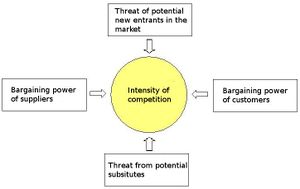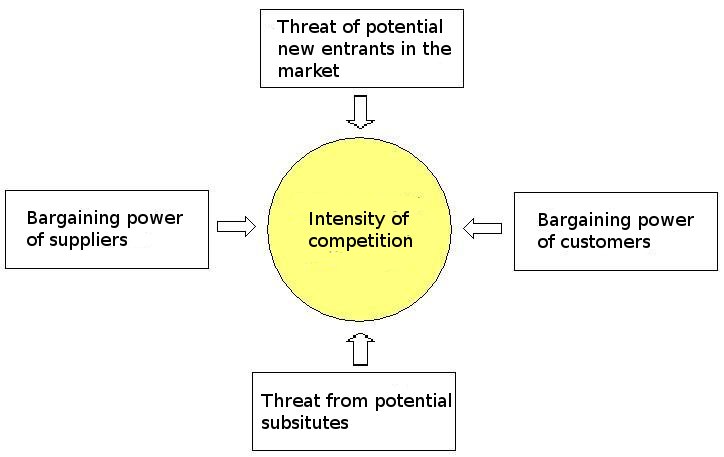Competitive environment
Competitive environment of organization is made up of all competitive or cooperative relationships. Organizations may facilitate the positive or negative (harming) activities towards each another. The competitive environment thus includes suppliers, customers, competitors, associations and chambers of industry, research institutes, clusters, etc.
Contents
- 1 Competitive Analysis
- 2 Examples of Competitive environment
- 3 Advantages of Competitive environment
- 4 Limitations of Competitive environment
- 5 Other approaches related to Competitive environment
- 6 References
Competitive Analysis
The purpose of the analysis of the competitive environment is:
- Estimate the attractiveness of the sector for companies that already operate in it, and for the new entrants or investors,
- Determine the prospects of individual sectors, opportunities and threats
- Definition of new, attractive sectors for the company in which it could invest.

Fig. 1. Five forces shaping the competition in the sector according to M. Porter
One method of competitive analysis is Porter's concept of five competitive forces. According to Porter the company's position in the market and the attractiveness of the market is determined by five factors:
- Threat of new competitors - is high, provided that the sector is economically attractive (large and increasing, profitable) while barriers to entry to the sector are not too high,
- Bargaining power of suppliers - is expressed in the possibility of raising prices or lowering quality of supplied raw materials, which in turn causes an increase in the cost of the company,
- Bargaining power of buyers - has a very large impact on the overall market situation and the situation of a particular company. IT is associated with the effectiveness of creating pressure on increasing quality of the products, lowering prices and increasing quality of services,
- Availability of substitutes - is connected with the possibility of substitution on the market. It automatically decreases the attractiveness of the industry, which is why the company should understand what is and what can become a substitute for its products and who is the real competitor of the company,
- The intensity of competition in the industry - mainly related to area of pricing, distribution, promotion and characteristics of the product itself and related services. Competition can be a threat to both the company's position in the sector and an opportunity to achieve competitive advantage, according to Porter competition in the market increases when companies see a chance to improve its market position.
Rating the attractiveness of the sector is based here on characterizing the formation of each of the forces and determine what opportunities and threats are associated with them. he lower the risk of emergence of new producers, the smaller is the importance of substitutes and less severe competitive struggle between the participants in the sector.
See also:
Examples of Competitive environment
- Business: The competitive environment of a business includes competitors, suppliers, customers, and other stakeholders such as the government, industry associations, and the media. This environment affects the performance of the business through the competitive strategies adopted by each of these stakeholders. For example, a business may be in competition with a rival business for customers, or a supplier may offer a discount to gain market share.
- Sports: The competitive environment of sports is similar to that of a business. It includes competitors, coaches, referees, spectators, sponsors, and the media. For example, a team may compete against another team on the field and use strategies to gain an advantage over their opponent. Additionally, coaches may use different tactics to gain an edge over their opponents, such as using specific strategies during the game or making changes to their team's lineup.
- Education: The competitive environment of education involves students, teachers, administrators, parents, and other members of the community. Students are in competition for grades and scholarships, while teachers may compete for teaching positions or for grants. Administrators may compete for funding and resources, while parents may compete for resources for their children. Additionally, the community may compete for resources from the school district, such as access to sports programs or music education.
Advantages of Competitive environment
- A competitive environment encourages organizations to stay ahead of the competition by driving innovation and quality improvement. This helps organizations remain competitive and build a better customer base.
- A competitive environment also encourages organizations to stay on top of the latest market trends and understand customer needs more effectively. This helps them develop products and services that are more attractive to their customers.
- A competitive environment can also spur price competition, which can be beneficial for customers who are looking for the best deal. This helps keep prices low, ensuring that customers have access to the best products and services at the best possible cost.
- Competition can also encourage organizations to focus on customer service and satisfaction, as customers will be more likely to switch to a competitor if they are unhappy with their current provider. This helps keep customers happy and loyal to their current provider.
- Lastly, a competitive environment can help organizations become more efficient and cost-effective, as they are forced to constantly innovate and find better ways to do business. This helps them remain competitive in the long run, ensuring their long-term success.
Limitations of Competitive environment
Competitive environment can have a few limitations.
- Firstly, competitive environment can be difficult to maintain. Organizations need to continuously adapt and keep up with the competitive landscape, which requires significant resources.
- Secondly, competitive environment can also lead to unethical competitive practices, such as price wars and predatory pricing, which can harm both the competitors and the customers.
- Thirdly, competitive environment can lead to a lack of collaboration between competitors, which can lead to a lack of innovation and creativity.
- Lastly, competitive environment can lead to an aggressive and hostile culture, which can negatively affect employee morale and engagement.
- Competitive analysis: This is the process of analyzing the competitive environment in order to identify strengths and weaknesses in order to gain an edge over competitors. It includes studying the products, pricing, and market strategies of the competition.
- Industry analysis: This process involves analyzing the industry to identify the current market trends and growth opportunities. It also involves looking at the competitive environment to determine the competitive advantages of the company.
- Market segmentation: This involves dividing the market into different segments based on customer needs and preferences. This helps companies identify and target specific customer groups more effectively.
- Distribution strategies: This involves analyzing the distribution channels and networks available to the company and determining which are the most effective and cost-efficient for reaching the target market.
- Product differentiation: This involves creating unique features or services that will set the company apart from its competitors.
- Pricing strategies: This involves determining the optimal price point that will maximize profit while still being competitive in the market.
In summary, competitive environment of organization includes competitive analysis, industry analysis, market segmentation, distribution strategies, product differentiation and pricing strategies. These approaches allow organizations to identify their competitive advantages and target the most effective strategies to gain an edge over their competitors.
| Competitive environment — recommended articles |
| Competitive rivalry — Competitor — Market development — Aggressiveness strategy — Competitive position — Threat of new entrants — Importance of international marketing — Market opportunity — Macro environment analysis |
References
- Porter, M. E. (2008). Competitive strategy: Techniques for analyzing industries and competitors. Simon and Schuster.
- Porter, M. E. (1998). Cluster and the new economics of competition.
- Porter, M. E. (1991). Towards a dynamic theory of strategy. Strategic management journal, 12(S2), 95-117.
- Porter, M. E., & Van der Linde, C. (1995). Toward a new conception of the environment-competitiveness relationship. The journal of economic perspectives, 9(4), 97-118.

